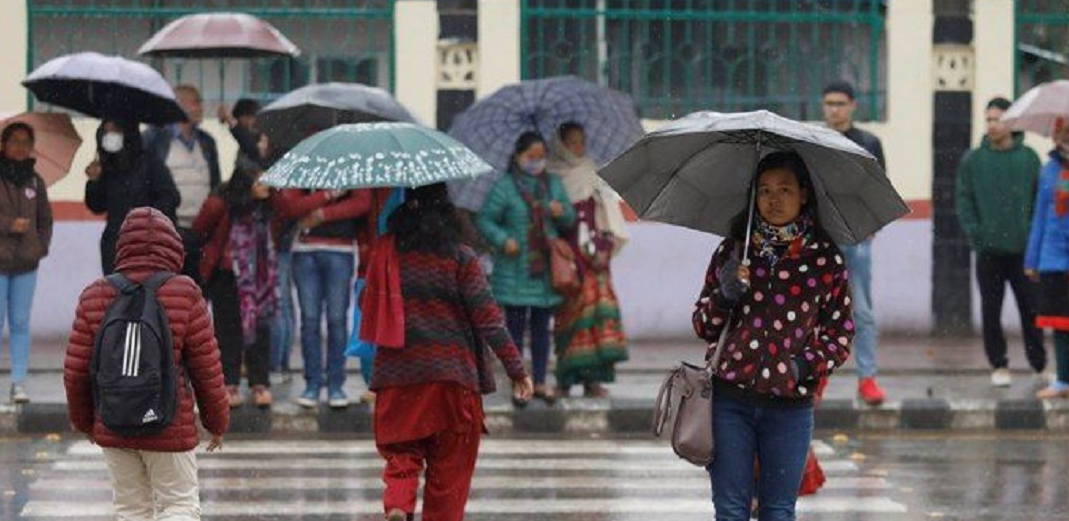Winter rain, snow throw life out of gear

By A Staff Reporter
Kathmandu, Jan. 18: Rainfall this winter season has affected normal life in the hill and Terai regions while thick snow has blanketed high mountainous regions.
All parts of the country, including the Kathmandu Valley, have been receiving rainfall from Thursday evening.
Heavy snowfall in several high mountainous areas has thrown normal life out of gear since Wednesday night, according to Meteorological Forecasting Division under the Department of Meteorology and Hydrology.
According to senior meteorologist Pratibha Manandhar at the MFD, this winter, Kathmandu and the whole nation have been receiving winter rainfall which happens seldom. The similar kind of winter rainfall had taken place in 2013/14.
She said that weather in the Kathmandu Valley will clear from Saturday afternoon while in western Nepal, the weather would improve from Friday evening. Due to regular rainfall, businesses in Kathmandu have been affected as the main Bazaars like Ason and Indrachowk remained almost deserted on Friday.
Meteorologist Manandhar said that the whole nation started receiving rain from Thursday night due to the impact of westerly wind that entered Nepal on Monday this week.
The present impact of the westerly disturbance is seen across the country and it is gradually moving towards east, senior Meteorologist Barun Poudel said. The formation of low atmospheric pressure in Nepal’s territory due to external wind pressure from north-west Nepal is presently causing rainfalls and snowfall in Nepal, he said.
Although it is raining in Kathmandu, people don’t have felt that much cold as the minimum temperature has not gone down to the level during the previous rainfall, he said.
The minimum temperature of the Kathmandu Valley was recorded 8.8 and the maximum temperature 14.9 degree Celsius on Friday morning.
This was the fourth winter rainfall that Kathmandu has experienced this winter.
In the last 24 hours, Kathmandu recorded 21 mm of rainfall. Bhairahawa received highest rainfall with 39 mm in the last 24 hours, according to the records.
In January, Kathmandu normally receives up to 14.4 mm rainfall, while the average minimum temperature stands at
around 2.4 degree Celsius during the normal time.
Kathmandu had the highest record of winter rainfall at 62 mm on January 16, 1996 and extreme minimum temperature was recorded minus 3.5 on January 11, 1978.
Winter drizzle is considered good for winter crops so the farmers have appeared happy over winter rainfall.
Raju Ratna Manandhar, a farmer, who hails from Gatthaghar, shared that this time Kathmandu witnessed favourable winter rainfall which had helped winter crops to grow. He said he was farming cauliflowers and cabbages and some seasonable crops at his farmland stretches in one ropani of land.
Meanwhile, many Himalayan districts of Karnali State received heavy snowfall on Thursday and Friday.
Bajhang and Doti received fourth snowfall of the season, making normal life difficult in the northern part of the districts.
Farmers in the two districts are worried as they are unable to take their cattle for grazing due to heavy rainfall.
The locals and their cattle remained indoors on Thursday and Friday.
Likewise, telephone, mobile phone and internet services were disturbed in Manang due to continuous snowfall, according to our Manang correspondent.
Recent News

Do not make expressions casting dout on election: EC
14 Apr, 2022
CM Bhatta says may New Year 2079 BS inspire positive thinking
14 Apr, 2022
Three new cases, 44 recoveries in 24 hours
14 Apr, 2022
689 climbers of 84 teams so far acquire permits for climbing various peaks this spring season
14 Apr, 2022
How the rising cost of living crisis is impacting Nepal
14 Apr, 2022
US military confirms an interstellar meteor collided with Earth
14 Apr, 2022
Valneva Covid vaccine approved for use in UK
14 Apr, 2022
Chair Prachanda highlights need of unity among Maoist, Communist forces
14 Apr, 2022
Ranbir Kapoor and Alia Bhatt: Bollywood toasts star couple on wedding
14 Apr, 2022
President Bhandari confers decorations (Photo Feature)
14 Apr, 2022











